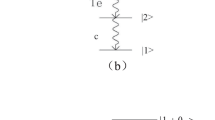Abstract
We study the tunable optomechanically induced absorption (OMIA) with the quantized field in the system, which consists of a driven cavity and a mechanical resonator with a super-conducting charge qubit via Jaynes-Cummings interaction. Such a OMIA can be achieved by controlling the strength of the Jaynes-Cummings interaction. Moreover, our work shows this OMIA for the quantized fields can be robust against cavity decay in somehow. With the combination of optomechanically induced transparency (OMIT), our proposal may have paved a new avenue towards quantum photon router.





Similar content being viewed by others
References
Wei, L.F., Liu, Y.X., Sun, C.P., Nori, F.: Phys. Rev. Lett. 97, 237201 (2006)
Marquardt, F., Girvin, S.M.: Physics 2, 40 (2009)
Guo, Y., Li, K., Nie, W., Li, Y.: Phys. Rev. A 90, 053841 (2014)
Ramos, T., Sudhir, V., Stannigel, K., Zoller, P., Kippenberg, T.J.: Phys. Rev. Lett. 110, 193602 (2013)
Lü, X.Y., Liao, J.Q., Tian, L., Nori, F.: Phys. Rev. A 91, 013834 (2015)
Aspelmeyer, M., Kippenberg, T.J., Marquardt, F.: Rev. Mod. Phys. 86, 1391 (2014)
Rabl, P.: Phys. Rev. Lett. 107, 063601 (2011)
Gong, Z.R., Ian, H., Liu, Y.X., Sun, C.P., Nori, F.: Phys. Rev. A 80, 065801 (2009)
Agarwal, G.S., Huang, S.: Phys. Rev. A 81, 041803 (2010)
Weis, S., Rivière, R., Deléglise, S., Gavartin, E., Arcizet, O., Schliesser, A., Kippenberg, T.J.: Science 330, 1520 (2010)
Karuza, M., Biancofiore, C., Bawaj, M., Molinelli, C., Galassi, M., Natali, R., Tombesi, P., Giuseppe, G., Vitali, D.: Phys. Rev. A 88, 013804 (2013)
Xiong, H., Si, L.G., Zheng, A.S., Yang, X., Wu, Y.: Phys. Rev. A 86, 013815 (2012)
Safavi-Naeini, A.H., Alegre, T.P.M., Chan, J., Eichenfield, M., Winger, M., Lin, Q., Hill, J.T., Chang, D., Painter, O.: Nature (London) 472, 69 (2011)
Wang, Y.D., Clerk, A.A.: Phys. Rev. Lett 108, 153603 (2012)
Wang, Y.D., Clerk, A.A.: New J. Phys. 14, 105010 (2012)
Dobrindt, J.M., Wilson-Rae, I., Kippenberg, T.J.: Phys. Rev. Lett. 101, 263602 (2008)
Gröblacher Hammerer, S.K., Vanner, M.R., Aspelmeyer, M.: Nature (London) 460, 724 (2009)
Zhang, J.Q., Li, Y., Feng, M., Xu, Y.: Phys. Rev. A 86, 053806 (2012)
Lezama, A., Barreiro, S., Akulshin, A.M.: Phys. Rev. A 59, 4732 (1999)
Liu, Y., Davanco, M., Aksyuk, V., Srinivasan, K.: Phys. Rev. Lett. 110, 223603 (2013)
Qu, K., Agarwal, G.S.: Phys. Rev. A 87, 031802 (2013)
Zhang, J.Q., Xiong, W., Zhang, S., Li, Y., Feng, M.: Annalen der Physik 527, 180 (2014)
Benkert, C., Scully, M.O., Bergou, J., Davidovich, L., Hillery, M., Orszag, M: Phys. Rev. A 41, 2756 (1990)
Agarwal, G.S., Huang, S.: Phys. Rev. A 85, 021801 (2012)
Wang, H., Gu, X., Liu, Y.X., Miranowicz, A., Nori, F.: Phys. Rev. A 90, 023817 (2014)
Acknowledgments
This work is supported by National Natural Science Foundation of China (Grant No. 61475045), the Natural Science Foundation of Hunan Province, China (Grant No. 2015JJ3092), and the School Foundation from the Hunan University of Arts and Science (Grants No. 14YB01 and No. 14ZD01).
Author information
Authors and Affiliations
Corresponding author
Appendix A
Appendix A
A set of linear quantum Langevin equations for the fluctuation operators can be written as
where
and
with A 1 = γ c −i ω, A 2 = iΔ c −2i g R e[b s ], A 3 = γ b −i ω, \(A_{4}=\frac {\gamma _{q}}{2}-i\omega \) and A 5 = γ q −i ω, where R e[Z] is define as the real part of Z.
with
where \(C(\omega )=iA_{4}A_{5}\lambda ^{2}\sigma _{zs}+4A_{4}\lambda ^{3}Re[b_{s}Re[\sigma _{-s}] +4A_{4}\lambda ^{2}|b_{s}|^{2}\omega _{b}+A_{5}\omega _{b}({A_{4}^{2}}+{\omega _{q}^{2}})\) and \(D(\omega )=\{4A_{4}\lambda ^{2}|b_{s}|^{2}({A_{3}^{2}}+{\omega _{b}^{2}})+A_{5}(A_{3}-i\omega _{b})(A_{4}-i\omega _{q})[A_{3}A_{4}-\lambda ^{2}|\sigma _{zs}|^{2} +i\omega _{b}(A_{4}+i\omega _{q})+iA_{3}\omega _{q}] +2\lambda ^{3}Re[b_{s}][2A_{3}A_{4}Re[\sigma _{-s}] +2A_{3}\omega _{q}Re[\sigma _{-s}]+2\omega _{b}(A_{4}Re[\sigma _{-s}]-\omega _{q}Re[\sigma _{-s}])]\}\). It is clear that the real and imaginary parts, with R e[E(ω)] and I m[E(ω)], describe the absorption and dispersion of the optomechanical system, respectively.
Rights and permissions
About this article
Cite this article
Wang, Q., Zhao, YH., He, Z. et al. Tunable Optomechanically Induced Absorption in a Hybrid Optomechanical System. Int J Theor Phys 55, 1324–1332 (2016). https://doi.org/10.1007/s10773-015-2773-1
Received:
Accepted:
Published:
Issue Date:
DOI: https://doi.org/10.1007/s10773-015-2773-1




